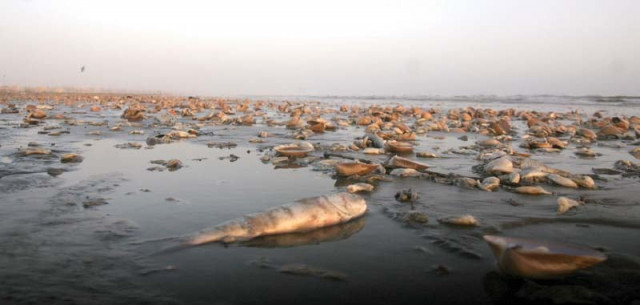Seashells strewn on the sea shore
Movement of monsoon winds led to millions of shells strewn along the coast

A large number of seashells are strewn along the Karachi coast. PHOTO: ATHAR KHAN/EXPRESS
As hundreds of visitors made their way to the beach to witness the extraordinary number of shells, the life guards shared their experience. "I have been on duty as a life guard since 2008 and this time I noticed the sea shells to be smaller and more brittle than those that make it to the shore in winters," said life guard Muhammad Ali.
The tragedy of Sea View's palm trees
Ali, who hails from a family of fishermen, said that there is a lot of pull in the waters around this season. "We call this season 'Jawaar'," he said. "The tides are both high and backward in trend."

Other people did not share Ali's enthusiasm. "There is nothing strange about the seashells that are covering the coast," said Sajjad Ali, a life guard who has been working at the beach for nine years. "Every year there is an increase in water movement around this season, due to which the fish come to the surface of the water and die. These shells are then left on the shores," he explained.
Ali went on to say that although bigger fish seldom make it to the surface, it is the smaller species like 'boi' that can be found and are often handpicked by people.
The coast guard's view was also shared by Moazzam Khan, technical adviser on marine fisheries for WWF-Pakistan. It wouldn't be right to say that they are this high in number every year but there are still quite a few that wash onto the shore every year, he said.
Khan linked the presence to the yearly movement of monsoon winds from the southwest direction in mid-May, which also extends to June sometimes. Water regimes change around this season to almost a clockwise manner due to which the animals living embedded in the soil die out and float to the surface, he explained.
Opening of Nishan-e-Pakistan monuments irks Sea View residents
Khan disagreed with Ali's claims that seashells wash ashore in the winters. "The wind speed is hardly around 10 knots. Hence, it is impossible for the fish to drift," he said. "Maybe, the reference is to species called blood clam, which was seen last year."
"The type that can be seen in this season is called Venus Clam, known locally as 'burger'," he said, adding that these clams are of export quality and their meat is taken out before exporting it, mainly to Thailand and Korea.
Apart from using seashells as collectibles and for decoration, Khan said they are of no commercial use. "They can be used to a certain level as a calcium supplement in poultry feed," he said. "But since calcium is not an expensive commodity, they are hardly used."
Published in The Express Tribune, May 23rd, 2016.



















COMMENTS
Comments are moderated and generally will be posted if they are on-topic and not abusive.
For more information, please see our Comments FAQ